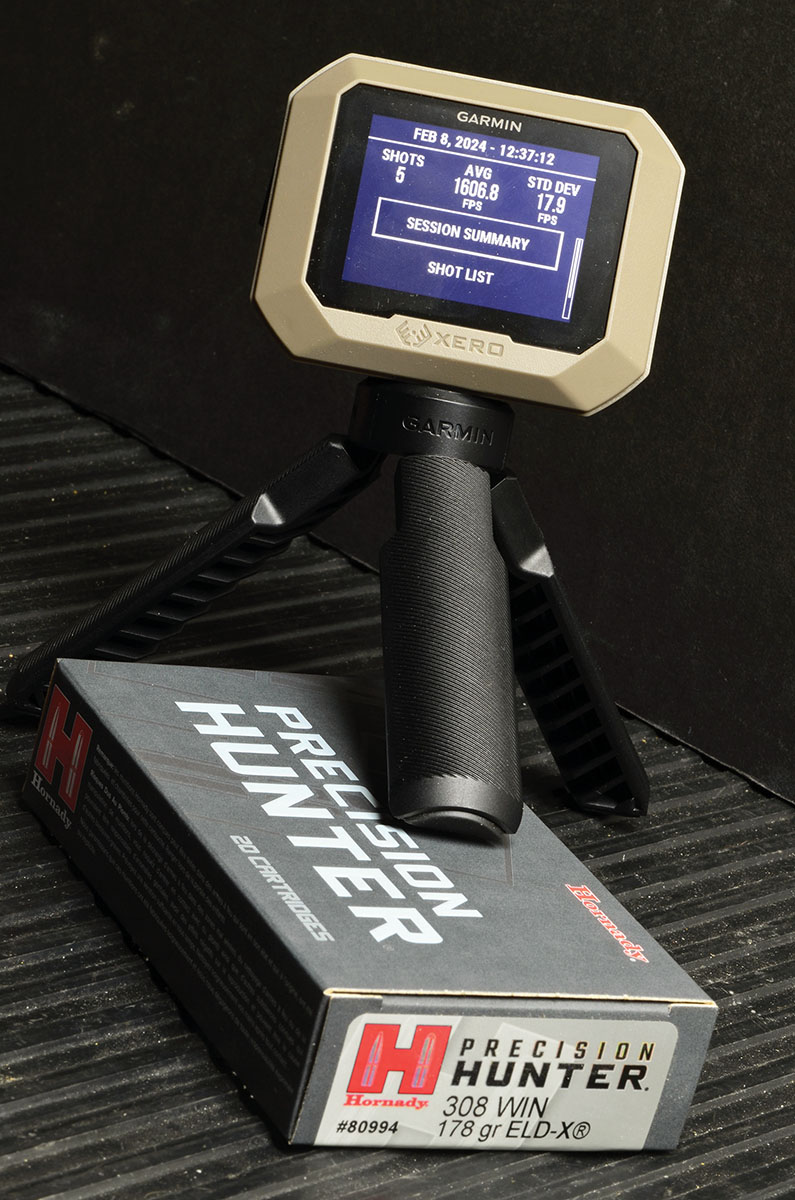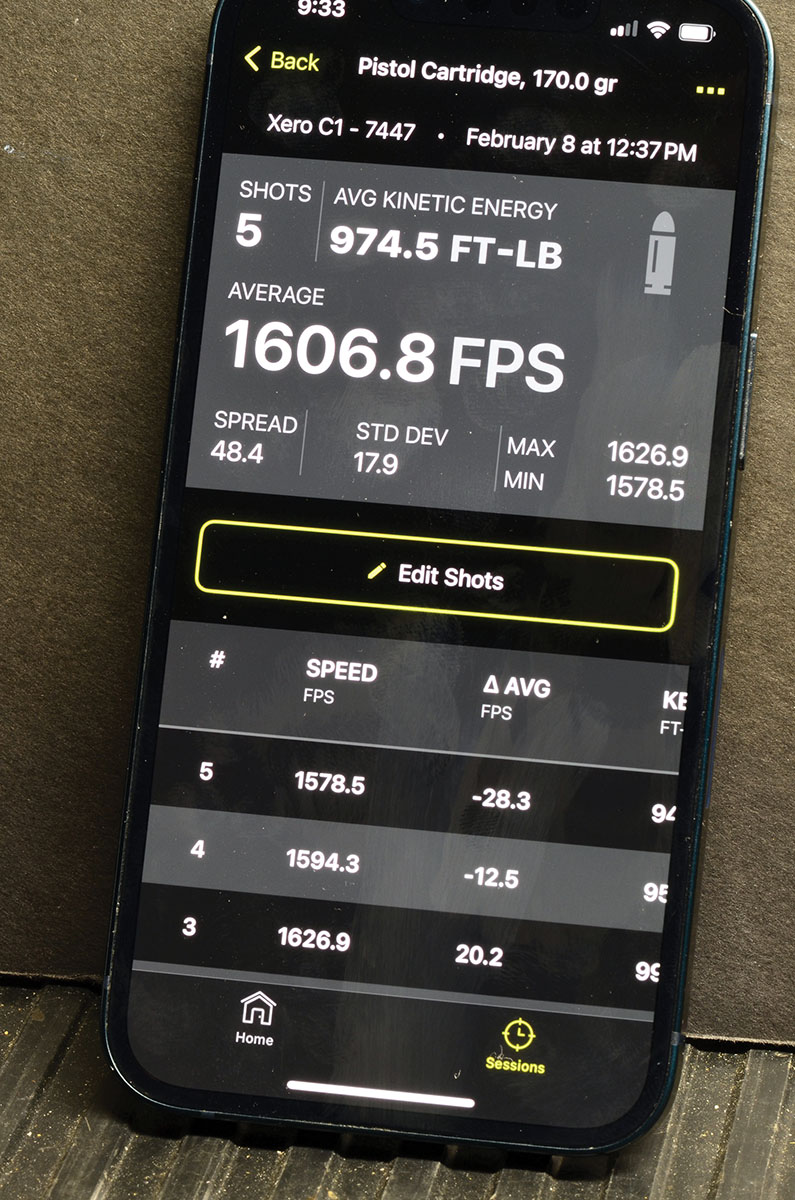In Range
Garmin Xero C1 Pro
column By: Terry Wieland | June, 24

My first was the Shooting Chrony (circa 1989), which was to personal chronographs what the Commodore 64 was to computers: The breakthrough that made them truly personal, put one on everyone’s desk or, in the case of the Chrony, in front of everyone’s shooting bench.
For those who weren’t around then, the Chrony was a simple metal box about the size of a box of chocolates that opened up to maybe 18 inches long. You fixed a cardboard screen to each end, turned it on, fired a shot through the screens, and got a velocity read-out on the simple shades-of-grey liquid crystal display. That was it, which may not seem like much, but for less than a hundred bucks, it changed everyone’s shooting world.
Way back then, if you wanted more features, such as a double velocity measurement to confirm accuracy, or a paper printout, you could get an Oehler Model 35, which cost quite a bit more, required two music stands to hold the long rod that held the screens, and involved cables and such. The only real problem with the Oehler was the chore of setting it up, especially on a public range.
With all the more convenient chronographs I’ve owned, wind and weather have always been a consideration. Poor sunlight, sun at the wrong angle, shade creeping over one screen, occasional raindrops – at one time or another, all have conspired to ruin a range session.
For the past half-dozen years, I’ve used a ProChrono in one model or another. My latest is the ProChrono LTD, its predecessor having given up the ghost. When that occurred, I logged on to MidwayUSA, found what I wanted, hit the ‘buy’ button, and it was waiting on my doorstep two days later, all for about a hundred dollars. Can’t hardly beat that.
Still, the ProChrono requires either a tripod or a solid flat surface to sit on, it still requires sunlight, and it’s still vulnerable to wind and rain.

Devotees of the weather channel will recognize the term Doppler radar, which is the system used by the Lab Radar. It sits on the front of the shooting bench, looks for a bullet to emerge from the muzzle, measures its velocity and reports back.
The Garmin also used Doppler radar, but is considerably smaller than the Lab Radar – about the size of a deck of playing cards – and comes with its own tiny tripod. Having never used the Lab Radar, I can’t compare further than that, so I will limit myself to singing the praises of the Garmin.
Garmin is primarily a consumer electronics company, for lack of a better term, and not part of the shooting industry per se, but it has established a reputation for breaking new ground in all kinds of ways. A couple of years ago, I got a Garmin Xero S1, which is a radar unit specially designed for trap shooters. It records each shot as you make it, tells you whether you hit or missed, and does all kinds of other things only a trapshooter would even care about. Its main attraction is that it tells you where your shot pattern was in relation to the clay.
A notable feature is that there is an app for your smartphone, with which the radar unit communicates using Bluetooth and this allows you to employ all kinds of other features.
I mention this because, having been more than impressed with the Xero S1, I was anxious to try the Xero C1 Pro – the chronograph for riflemen, pistoleers and archers.
Like the S1, the C1 Pro has an app – “ShotView” – and while the unit itself will record and store dozens of strings and hundreds of shots, it automatically sends all the information to the app, which then allows you to manipulate it, and study it even more.
At this point, one could get into detailed technical analysis and comparison with competitive systems, but I won’t. Like most users, I am primarily interested in how well it works for the admittedly basic purposes for which I want a chronograph, how convenient and reliable it is.
A friend who managed to get a Garmin early on fired 120 shots over it without a single glitch or failure to read. That may not be definitive, but it certainly indicates a high level of reliability and only long-term use can prove it one way or the other.
Convenience? The entire Garmin unit, including the tripod, weighs less than 6 ounces – one-third the weight of a box of 20 308s and about the same size. The Garmin can literally be slipped into a pocket.
Since it sits on the shooting bench, about a foot to the side and a foot behind the muzzle of the firearm, setting it up is no effort at all. My first day out, it was blowing hard enough that it would have toppled my conventional chronograph, but the Garmin sat there without a tremor, happily recording shot after shot. My phone was in the car. As soon as I got in, the Garmin sent the information to the app, and it was right there when I got to the clubhouse and turned it on.
It would be rash to predict that this is the last word in Doppler radar velocity measuring. Undoubtedly, competitors will spring up; applications will increase and, probably, the price will come down. But, at $600, the unit is within reach of most of us. A quick inflation calculation indicated that is a little more than twice what the Shooting Chrony cost in 1989, which makes it a king-sized bargain.
It would also be going too far to say the Garmin has solved every problem I’ve ever had with a chronograph, going back 35 years, but it’s very close. In fact, I can’t think of one. If I do, I’ll let you know.
.jpg)


